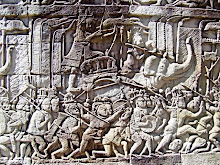Government Suppresses Peaceful Protests for Religious, Cultural, and Land Rights
January 21, 2009
Vietnam's response to peaceful protests provides a window into the severe and often shrouded methods it uses to stifle dissent. The government should be trying to engage in dialogue with the Khmer Krom, rather than throwing them in jail.
Brad Adams, Asia director at Human Rights Watch.
(New York, January 21, 2009) - The Vietnamese government should immediately free Khmer Krom Buddhist monks and land rights activists in prison or under house arrest for the peaceful expression of their political and religious beliefs, Human Rights Watch said in a report released today. The Khmer Krom is a large ethnic group in the Mekong Delta that is central to Vietnam-Cambodia relations.
The 125-page report, "On the Margins: Rights Abuses of Ethnic Khmer in Vietnam's Mekong Delta," documents ongoing violations of the rights of the Khmer Krom in southern Vietnam and also abuses in Cambodia against Khmer Krom who have fled there for refuge. Wary about possible Khmer Krom nationalist aspirations, Vietnam has suppressed peaceful expressions of dissent and banned Khmer Krom human rights publications. It also tightly controls the Theravada Buddhism practiced by the Khmer Krom, who see this form of Buddhism as the foundation of their distinct culture and ethnic identity.
"Vietnam's response to peaceful protests provides a window into the severe and often shrouded methods it uses to stifle dissent," said Brad Adams, Asia director at Human Rights Watch. "The government should be trying to engage in dialogue with the Khmer Krom, rather than throwing them in jail."
Drawing on detailed interviews with witnesses in both Vietnam and Cambodia, the report shows that Khmer Krom in Vietnam face serious restrictions on freedom of expression, assembly, association, information, and movement. In researching this report, Human Rights Watch came into possession of internal memos circulated by the Communist Party of Vietnam and Vietnamese government officials outlining their concerns about unrest among Khmer Krom in the Mekong Delta and strategies to monitor, infiltrate, and silence Khmer Krom activists. The documents are included in an appendix to the report.
"The official documents we publish today lay bare the efforts by the Vietnamese government to silence critics," said Adams. "This is bare-knuckled, indefensible political repression."
"On the Margins" provides a rare, in-depth account of a protest conducted by 200 Khmer Krom Buddhist monks in Soc Trang province, Vietnam, in February 2007. Protesters called for greater religious freedom and more Khmer-language education. Although the protest was peaceful and lasted only a few hours, the Vietnamese government responded harshly. Police surrounded the pagodas of monks suspected of leading the protest. Local authorities and government-appointed Buddhist officials subsequently expelled at least 20 monks from the monkhood, forcing them to defrock and give up their monks' robes, and banishing them from their pagodas. The authorities sent the monks back to their home villages and put them under house arrest or police detention, without issuing arrest warrants or specifying the charges against them. During interrogations, police beat some of the monks.
In May 2007, the Soc Trang provincial court convicted five of the monks on charges of "disrupting traffic" and sentenced them to two to four years of imprisonment. Some of the monks were beaten during interrogation. After the demonstrations, the authorities instituted stricter surveillance of Khmer Krom activists, restricted and monitored their movements, banned their publications, and monitored their telephones.
The report also examines rights abuses of Khmer Krom who have moved to Cambodia, where they remain among Cambodia's most disenfranchised groups. Because they are often perceived as ethnic Vietnamese by Cambodians, many Khmer Krom in Cambodia face social and economic discrimination and unnecessary hurdles to legalizing their status.
The Cambodian government has repeatedly stated that it considers the Khmer Krom to be Cambodian citizens. Yet the Cambodian authorities often react harshly when Khmer Krom become too critical of the Vietnamese government, a close ally of the Cambodian government. In 2007, Cambodian police forcefully dispersed a series of protests in Phnom Penh by Khmer Krom monks denouncing the rights abuses they had experienced in Vietnam.
In February 2007, a Khmer Krom monk, Eang Sok Thoeun, was killed in suspicious circumstances after he participated in a protest in Phnom Penh. In June 2007, Cambodian authorities arrested, defrocked, and deported to Vietnam a Khmer Krom activist monk, Tim Sakhorn, who was sentenced in Vietnam to a year in prison. Human Rights Watch called on the Cambodian government to investigate thoroughly the killing of Eang Sok Thoeun, and on the Vietnamese government to allow Tim Sakhorn, placed under house arrest in Vietnam after his release from prison in May 2008, to return to his home in Cambodia if he chooses.
"The killing, imprisonment, and defrocking of Khmer Krom monks sends a chilling message to Khmer Krom activists in both Cambodia and Vietnam," said Adams. "An ethnic group that should enjoy the protection of two countries finds itself stripped of protection by both."




